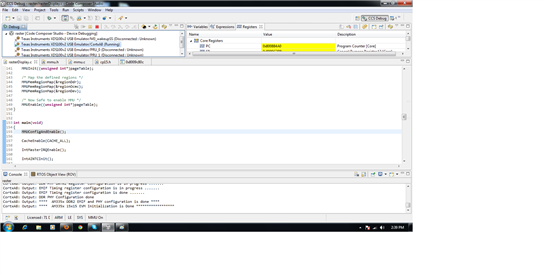I am working on getting MMU working on AM335x, we have our own custom board (closer design to Beagleboard) with NAND flash
i am able to boot from NAND flash, now i want to use MMU in my code, i am using Codesourcery GCC ver 4.2.3 to compile my own written standalone code
i have used MMU code from Starterware (ver 02.00.00.06) code, but my code stops executing after CP15MMUEnable(); i have used all same code from starterware for MMU, i have verified pageTable address and also verified that entries in pageTable are correct
My code boots from NAND flash, then i copy my initial bootloader to DDR2 RAM at address 0x80000000 and then jump DDR2 for execution, (i want to enable MMU for whole DDR2 memory region) there are certain messages i sent to terminal through UART0, and my code boots up preoperly, but when i try to enable MMU, at CP15MMUEnable, it halts and does not send the characters to terminal after this instruction, am i doing something wrong?
My MMU pageTable address is at 0x83904000 which is 16K boundary aligned as instructed
Below is the code patch i am using to enable MMU, which is taken from starterware code
/*
** Function to setup MMU. This function Maps three regions ( 1. DDR
** 2. OCMC and 3. Device memory) and enables MMU.
*/
void MMUConfigAndEnable(void)
{
/*
** Define DDR memory region of AM335x. DDR can be configured as Normal
** memory with R/W access in user/privileged modes. The cache attributes
** specified here are,
** Inner - Write through, No Write Allocate
** Outer - Write Back, Write Allocate
*/
REGION regionDdr = {
MMU_PGTYPE_SECTION, START_ADDR_DDR, NUM_SECTIONS_DDR,
MMU_MEMTYPE_NORMAL_NON_SHAREABLE(MMU_CACHE_WT_NOWA,
MMU_CACHE_WB_WA),
MMU_REGION_NON_SECURE, MMU_AP_PRV_RW_USR_RW,
(unsigned int*)pageTable
};
/*
** Define OCMC RAM region of AM335x. Same Attributes of DDR region given.
*/
REGION regionOcmc = {
MMU_PGTYPE_SECTION, START_ADDR_OCMC, NUM_SECTIONS_OCMC,
MMU_MEMTYPE_NORMAL_NON_SHAREABLE(MMU_CACHE_WT_NOWA,
MMU_CACHE_WB_WA),
MMU_REGION_NON_SECURE, MMU_AP_PRV_RW_USR_RW,
(unsigned int*)pageTable
};
/*
** Define Device Memory Region. The region between OCMC and DDR is
** configured as device memory, with R/W access in user/privileged modes.
** Also, the region is marked 'Execute Never'.
*/
REGION regionDev = {
MMU_PGTYPE_SECTION, START_ADDR_DEV, NUM_SECTIONS_DEV,
MMU_MEMTYPE_DEVICE_SHAREABLE,
MMU_REGION_NON_SECURE,
MMU_AP_PRV_RW_USR_RW | MMU_SECTION_EXEC_NEVER,
(unsigned int*)pageTable
};
/* Initialize the page table and MMU */
MMUInit((unsigned int*)pageTable);
/* Map the defined regions */
MMUMemRegionMap(®ionDdr);
MMUMemRegionMap(®ionOcmc);
MMUMemRegionMap(®ionDev);
/* Now Safe to enable MMU */
MMUEnable((unsigned int*)pageTable);
}
void MMUInit(unsigned int *masterPt)
{
unsigned int idx;
/* Invalidate the TLB entries */
CP15TlbInvalidate();
/* Set domain access rights */
CP15DomainAccessClientSet();
/* Disable TEX remapping, Access Flag usage and alignment check */
CP15ControlFeatureDisable( CP15_CONTROL_TEXREMAP
| CP15_CONTROL_ACCESSFLAG
| CP15_CONTROL_ALIGN_CHCK
| CP15_CONTROL_MMU);
/* Configure the TTB Control register to use only TTB0 */
CP15TtbCtlTtb0Config();
/* Se the master page table with fault entries */
for(idx = MMU_PAGETABLE_NUM_ENTRY; idx !=0; idx--)
{
*masterPt++ = MMU_PAGETABLE_ENTRY_FAULT;
}
}
void MMUMemRegionMap(REGION *region)
{
unsigned int *ptEntryPtr;
unsigned int ptEntry;
int idx;
/* Get the first entry in the page table to set */
ptEntryPtr = region->masterPtPtr +
(region->startAddr >> MMU_PAGEBOUND_SHIFT);
/* Set the pointer to the last entry */
ptEntryPtr += (region->numPages - 1);
/* Get the start Address MSB 3 nibbles. Ignore extended address */
ptEntry = (region->startAddr & region->pgType) & MMU_PGADDR_MASK;
/*
** Update the page table entry with memory attributes and
** Access Permissions and Security.
** All the regions will be marked as global.
*/
ptEntry |= ((MMU_PGTYPE_MASK & region->pgType)
| region->accsCtrl | region->memAttrib
| region->secureType);
/* Set the entries in the page table for the region attributes */
for(idx = (region->numPages - 1); idx >= 0; idx--)
{
*ptEntryPtr-- = ptEntry + (idx << MMU_PAGEBOUND_SHIFT) ;
}
}
void MMUEnable(unsigned int *masterPt)
{
/* Set TTB0 register */
CP15Ttb0Set((unsigned int)masterPt);
/* Enable MMU */
CP15MMUEnable();
}
Please help !!!


